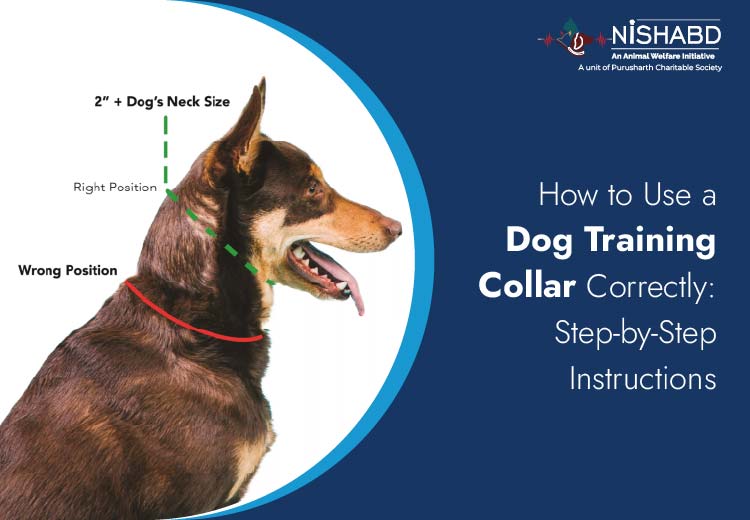The training of a dog requires patience, time, dedication, and consistency. Many pet owners use a collar for dogs to control their behavior and to communicate. It is crucial to use the collar in the right way. If it is used properly, it can aid your dog in learning faster. However, If used incorrectly, it can create confusion or even scare you and your dog.
This blog will guide you on how to train dogs with a collar for training that doesn’t cause injuries or stress.
Also Read: Are You Tying Your Dog for Too Long Without Realizing It?
Types of Dogs Training Collars
There are a variety of collars for dogs, and each one functions differently. Before you choose a collar, it is important to be aware of its function and check if it is a good fit for the dog’s size, shape, and degree of satisfaction. The collar must be worn in a manner that is gentle and respectful.
Here are some common types:
-
- Prong Collar
How it works:
A prong collar consists of small, round metal links, which are positioned in the collars of dogs. If the dog pulls, it puts pressure on them to remind them to slow down.
Purpose:
It is often used to describe powerful and large dogs who pull a lot during walks.
Important Note:
The collar has to be handled with care and only under the supervision of a dog expert who has been trained. If you don’t use it correctly, it can create discomfort or anxiety. If you’re not sure whether you are using the correct method, it is better to choose a more gentle option. - E-Collar (Electronic Collar)
How it works:
A collar with an electronic chip sends a subtle and gentle signal (like a small tap or buzz) to get your dog’s attention.
Purpose:
It can be used to provide off-leash training, or to correct behavior such as excessive barking or jumping.
Important Note:
This collar is best used by an experienced trainer. If you use it improperly, it can lead to anxiety or even confusion for your dog. The goal should never be to scare your pet. - Vibration Collar
How it works:
This collar will give gentle vibration when the dog is required to be attentive.
Purpose:
It is frequently used in basic obedience training particularly to train commands like “come,” “sit,” or “stop.”
Important Note:
It is generally an option for gentle dogs. But, it’s essential to match the sound with positive rewards such as treats and praise, so that your dog learns happily. - Citronella Collar
How it works:
The collar sprays a light mist (a scent that many dogs dislike) when your dog is barking excessively.
Purpose:
It is used primarily to reduce barking.
Important Note:
Some dogs react well to this, whereas others won’t react to it at all. Be aware of your dog’s behavior to make sure they’re not unhappy or stressed.
- Prong Collar
Source: toledodogtrainers .com
Important Reminder
No matter which collar for dogs you choose:
-
- Training should always be gentle.
- Your dog must feel secure and be understood.
- Use positive reinforcement (praise, treats, affection)
- If your dog is nervous or confused then stop and try a gentler approach.
The key to understanding how to train dogs is love, patience and commitment – not forcibly.
Step-by-Step Guide to Using a Dogs Training Collar
Step 1: Choose the Right Collar for Dogs
Choose an appropriate collar for your needs.
-
- It should neither be too loose, nor too tight.
- You should be able to slip two fingers between the collar and your dog’s neck.
- Check your dog’s fur and skin regularly to avoid irritation.
Choosing the correct size is the first step in how to train dogs safely.
Step 2: Introduce the Collar Slowly
Before starting your training, allow your dog to become comfortable wearing the collar.
-
- You can put it on for short periods at home.
- Allow your dog to walk around freely.
- Reward with treats and praise.
If your dog is comfortable it is much easier to train him.
Step 3: Teach Basic Commands First
A dog collar works best when combined with the use of a voice command. Start with simple commands:
-
- Sit
- Stay
- Come
- Stop
Give your dog the command and gently guide it with the collar. Praise when your dog follows through. This will help build confidence and trust. This is one of the most fundamental lessons in how to train dogs.
Step 4: Use a Light and Gentle Hand
Training should never be a struggle of pulling or juggling the collar.
-
- Use soft, short movements.
- Give clear voice commands.
- Always reward good behaviour.
Your dog should feel guided, not pressured.
Step 5: Keep Training Sessions Short
Dogs learn the best when lessons are short and fun.
-
- Train for around 10 to 15 minutes at once.
- Do it regularly or at least every two days.
- End training with praise, treats, or playtime.
Short lessons will keep your dog entertained and eager to learn.
Step 6: Be Consistent
Using the collar for dogs is effective if you are consistent in your training.
Use the same:
-
- Words
- Tone
- Hand movement
This can help your dog understand what you’re trying to communicate and reduce confusion. Consistency is at the core of how to train dogs effectively.
Signs Your Dog is Comfortable
Your dog is well-trained when they:
-
- Wag their tail
- Look relaxed
- Respond when asked
- Display interest and curiosity
If your dog looks worried or anxious, take a short break.
Conclusion
Using a collar for dogs correctly can make training simpler and clearer. It can also make training more comfortable for you and your dog. Remember, that the key in how to train dogs is the love and patience that you bring to each training session. When your training feels secure and enjoyable your dog will learn with confidence and with joy.
FAQs
Q1. When should I start teaching my dog to wear the collar?
You can start with your dog when it is between eight to twelve weeks of age. Begin slowly and let the dog adjust to the collar gradually.
Q2. How long does it take for a dog to learn commands?
Every dog learns in a different way. If you practice it regularly and are patient the majority of dogs learn basic commands within 2 to 4 weeks.
Q3. Can I train my pet without a collar?
Yes. You can also use treats, hand signals, and your voice to train. The collar is just one helpful tool, not the only way.

